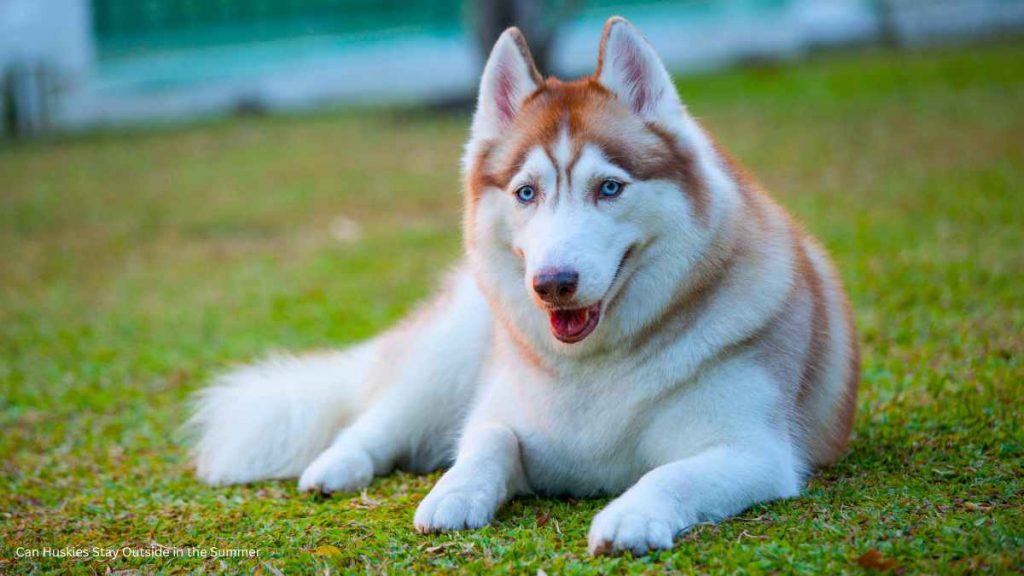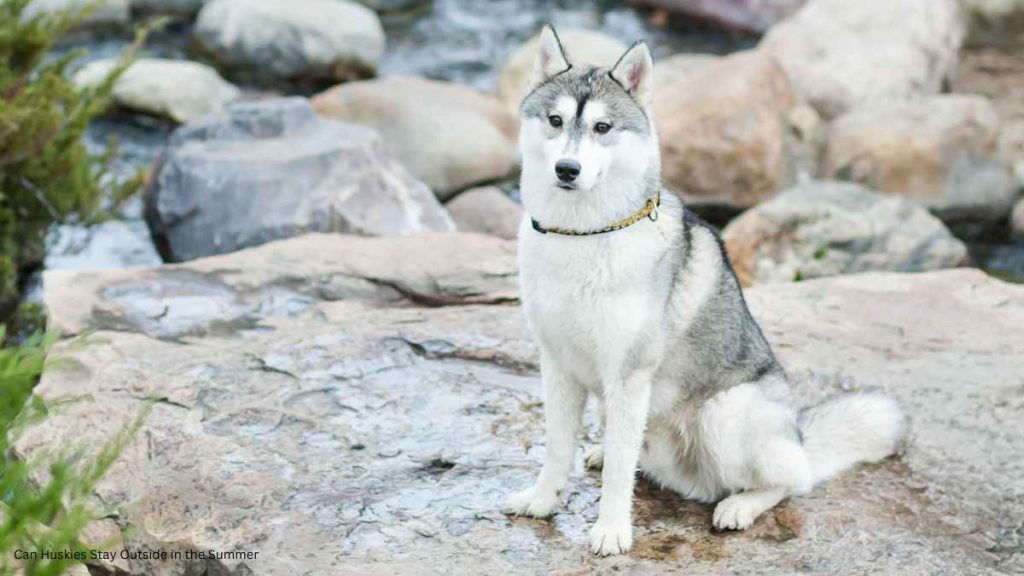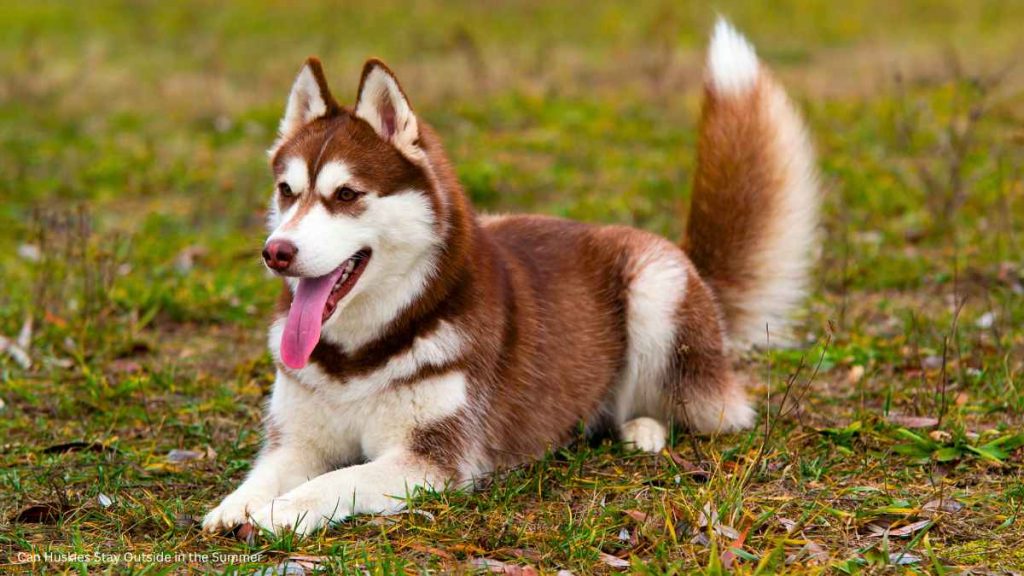Huskies are a unique breed of dogs known for their striking appearance and remarkable endurance. Originating from regions with cold climates, such as Siberia, huskies have adapted to thrive in harsh, wintry conditions. However, their ability to withstand warmer temperatures, particularly during the summer months, is a topic of concern for many husky owners. In this article, we will explore the question, “Can huskies stay outside in the summer?” and delve into the factors that influence their outdoor stay during hot weather.
Table of Contents
Overview of Huskies as a Breed
Huskies are medium-sized dogs with a strong, muscular build. They are known for their thick double coat, which serves as insulation against the cold and provides protection from extreme weather conditions. The breed encompasses several variations, including Siberian Huskies, Alaskan Huskies, and Malamutes, each with its own unique traits and characteristics.
Adaptability of Huskies to Different Weather Conditions
Huskies have a remarkable adaptability to different weather conditions, thanks to their genetic makeup and evolutionary history. Their double coat consists of a dense, insulating undercoat and a longer, coarser outer coat that helps regulate their body temperature. This specialized coat provides insulation during colder months by trapping warm air close to the body and acts as a barrier against snow and wind.
In colder climates, huskies thrive and display their natural affinity for lower temperatures. Their thick coat and overall physiology enable them to withstand frigid temperatures and engage in activities such as sledding and pulling heavy loads over vast snowy terrains. However, when it comes to hotter climates, the breed faces unique challenges due to their thick coat and inherent heat sensitivity.

Can Huskies Stay Outside in the Summer?
While huskies have a natural tolerance for colder temperatures, their ability to cope with summer heat varies among individuals and depends on several factors. It’s important to consider these factors when deciding whether a husky can stay outside during the summer months:
1. Temperature and Humidity Levels: Huskies are more comfortable in cooler temperatures, typically ranging between 50°F to 85°F (10°C to 29°C). High humidity can also increase the discomfort for huskies as they have a limited ability to sweat and cool down.
2. Access to Shade and Water: Providing ample shade is crucial for huskies during the summer. They should have access to shaded areas where they can seek relief from the sun’s direct heat. Additionally, a constant supply of fresh water is essential to keep them hydrated.
3. Ventilation and Airflow: Proper airflow and ventilation are necessary to prevent heat from accumulating in the designated outdoor area. This helps dissipate heat and maintain a cooler environment.
4. Health and Age of the Husky: The health and age of the husky play a significant role in their ability to tolerate heat. Older huskies, puppies, or those with underlying health conditions may be more susceptible to heat stress and require extra care and attention.
5. Signs of Discomfort or Distress: It is crucial to closely monitor huskies for signs of discomfort or distress during hot weather. These signs may include excessive panting, lethargy, drooling, or seeking cool surfaces.
Characteristics of Huskies
A. Origins and History of Huskies
Huskies have a rich history that traces back thousands of years. Originating from the cold regions of northeastern Asia, specifically Siberia, huskies were primarily bred by the Chukchi people. These indigenous Siberian nomads relied on these dogs for transportation, hunting, and companionship in their harsh environment.
The Chukchi people selectively bred huskies to develop a resilient and efficient working dog capable of enduring long distances in freezing temperatures. This selective breeding process led to the development of a highly adaptable and hardy breed that could pull sleds, traverse icy terrains, and navigate through snowstorms. Huskies played a vital role in the survival and livelihood of the Chukchi people.
B. Natural Adaptations for Cold Climates
Huskies possess a range of natural adaptations that enable them to thrive in cold climates:
1. Thick Double Coat: One of the most distinctive features of huskies is their thick double coat. The double coat consists of a dense, soft undercoat and a longer, coarser outer coat. This combination provides excellent insulation by trapping warm air close to the body, keeping the huskies warm even in freezing temperatures.
2. Fur Color and Pattern: The fur color and pattern of huskies contribute to their adaptability in snowy landscapes. Their coat colors vary and can include black, white, gray, red, and a combination of these. The markings on their faces and bodies often resemble masks and stripes, which can provide camouflage in snowy environments.
3. Well-Developed Paws: Huskies have strong, well-developed paws that are designed to tackle icy and snowy terrains. Their large, webbed feet help them maneuver through thick snow, providing traction and stability.
4. Efficient Respiratory System: Huskies have an efficient respiratory system that enables them to take in and circulate cold air effectively. Their nasal passages and lungs are adapted to prevent frost from entering and damaging their respiratory system.
C. The Role of Huskies’ Thick Double Coat
The thick double coat of huskies serves multiple purposes and plays a vital role in their survival in cold climates:
1. Insulation: The dense undercoat acts as a natural insulator, trapping air close to the body and providing an extra layer of warmth. This insulation helps regulate the huskies’ body temperature and protects them from the cold.
2. Water-Repellent Outer Coat: The outer coat of huskies consists of longer guard hairs that are water-repellent. This helps prevent moisture from reaching the skin and keeps the undercoat dry, maintaining the insulating properties.
3. Protection from UV Rays: The double coat of huskies also provides protection from harmful UV rays. The longer guard hairs shield the skin from sunburn and potential damage caused by prolonged exposure to sunlight.
4. Adaptability: While the thick double coat primarily serves to protect huskies from the cold, it also allows them to adapt to a wide range of temperatures. During warmer months, the undercoat naturally sheds, allowing for better airflow and heat dissipation.
It is important to note that while huskies are well-equipped for cold climates, their thick coat can pose challenges in hot and humid environments. Their adaptations that enable them to withstand freezing temperatures can make them more susceptible to heat stress or heatstroke in hotter climates. Therefore, it is crucial to take appropriate measures to ensure their comfort and well-being during the summer months. In the next sections, we will explore the heat sensitivity of huskies and factors to consider for their outdoor stay in summer.
Heat Sensitivity of Huskies
A. Challenges Huskies Face in Hot Weather
Huskies, with their thick double coat designed for cold climates, face several challenges when exposed to hot weather conditions:
1. Limited Sweat Glands: Unlike humans, huskies have a limited number of sweat glands, mainly located on their paws. This means they rely less on sweating as a means of cooling down. Instead, they primarily regulate their body temperature through panting.
2. Insulation and Heat Retention: The huskies’ double coat, while highly efficient in insulating them from the cold, can trap heat during hot weather. The dense undercoat, combined with the outer coat, creates a barrier that hinders the dissipation of heat from the body.
3. Difficulty in Cooling Down: Huskies’ natural cooling mechanism, panting, may not be as effective in high temperatures and humidity. They are less efficient at expelling heat through panting compared to breeds with shorter snouts. This can lead to an increased risk of overheating.
4. Dehydration Risk: Huskies’ increased heat sensitivity puts them at a higher risk of dehydration. They may lose fluids more rapidly through panting and may not always recognize their need for adequate water intake.
B. Signs of Heat Stress or Heatstroke in Huskies
It is crucial for husky owners to be aware of the signs of heat stress or heatstroke in their pets. Prompt recognition and intervention are essential to prevent serious health complications. Some common signs include:
1. Excessive Panting: Huskies will pant to cool themselves down. However, excessive, rapid, or labored panting can indicate heat stress.
2. Lethargy and Weakness: If a husky appears unusually tired or weak, it may be a sign of heat-related distress. They may seem uninterested in activities they typically enjoy.
3. Excessive Drooling: Increased drooling, with saliva appearing thicker or stringy, can indicate heat stress.
4. Bright Red Gums and Tongue: The gums and tongue of a heat-stressed husky may turn bright red. In severe cases, they may even become bluish or purple.
5. Vomiting or Diarrhea: Heat stress can lead to gastrointestinal distress, causing vomiting or diarrhea.
6. Staggering or Lack of Coordination: A husky suffering from heatstroke may display a lack of balance, coordination, or even collapse.
7. Rapid Heart Rate and Elevated Body Temperature: Huskies experiencing heatstroke may have an abnormally fast heart rate and an elevated body temperature (above 104°F or 40°C).
If a husky shows any signs of heat stress or heatstroke, immediate steps should be taken to cool them down. Move the dog to a cool, shaded area, provide access to fresh water, and use cool (not cold) water to dampen their fur. It is crucial to seek veterinary assistance promptly for further evaluation and treatment.
Understanding the challenges huskies face in hot weather and being vigilant about the signs of heat-related distress allows owners to take necessary precautions and ensure the well-being of their beloved pets. In the next section, we will explore the factors to consider when deciding whether huskies can stay outside in the summer.

Factors to Consider for Outdoor Stay in Summer
A. Temperature and Humidity Levels
When deciding whether huskies can stay outside in the summer, it is crucial to consider the temperature and humidity levels:
1. Optimal Temperature Range: Huskies are more comfortable in cooler temperatures, typically ranging between 50°F to 85°F (10°C to 29°C). Higher temperatures can increase the risk of heat-related issues.
2. High Humidity Concerns: Humidity can exacerbate the discomfort for huskies as it affects their ability to cool down through panting. High humidity levels can hinder the evaporation of moisture from their respiratory system and make it more challenging for them to dissipate heat.
B. Access to Shade and Water
Providing ample shade and access to water is essential to keep huskies cool and hydrated:
1. Shaded Areas: Ensure that the designated outdoor area for the husky has adequate shade throughout the day. This could be provided by trees, canopies, or structures that offer protection from direct sunlight.
2. Fresh Water Supply: Always provide clean, fresh water in a shaded location for the husky to drink from. Regularly check and refill the water bowl to ensure it remains accessible and cool.
C. Ventilation and Airflow
Creating a well-ventilated space is crucial to prevent heat buildup:
1. Proper Air Circulation: Ensure that the outdoor area has sufficient airflow and ventilation. This can be achieved by selecting an open area or using fans to promote air circulation.
2. Avoid Hot Surfaces: Huskies can be sensitive to hot surfaces, such as concrete or asphalt, which can radiate heat and contribute to discomfort. Consider providing cooling mats or surfaces for them to lie on.
D. Evaluating Health and Age of the Husky
The health and age of the husky play a significant role in determining their ability to tolerate hot weather:
1. Underlying Health Conditions: Huskies with pre-existing health conditions, such as respiratory problems or heart issues, may have a reduced ability to handle heat. Consult with a veterinarian to assess the husky’s health and discuss any specific precautions or restrictions.
2. Age Considerations: Puppies and older huskies are generally more vulnerable to heat-related stress. They may have a harder time regulating their body temperature and may require extra care and attention during hot weather.
E. Monitoring Signs of Discomfort or Distress
Regularly monitoring the husky for signs of discomfort or distress is vital:
1. Behavioral and Physical Signs: Pay attention to signs of panting, excessive drooling, restlessness, seeking cool surfaces, or attempting to dig holes for cooler ground. These can indicate that the husky is uncomfortable in the heat.
2. Adjusting Outdoor Time: Consider limiting the husky’s time outdoors during peak heat hours. Opt for early morning or late evening activities when temperatures are cooler.
By carefully considering these factors and taking necessary precautions, it is possible for huskies to stay outside in the summer. However, it is crucial to prioritize their well-being and make informed decisions based on their individual needs and overall health. In the next section, we will explore additional measures to ensure the well-being of huskies during the summer months.
Ensuring the Well-being of Huskies in Summer
A. Providing Suitable Shelter or Doghouse
Creating a suitable shelter or doghouse for huskies is essential to protect them from the heat:
1. Size and Ventilation: The shelter should be spacious enough for the husky to move around comfortably. It should also have proper ventilation to allow for airflow and prevent heat buildup.
2. Insulation: Consider using materials that provide insulation, such as reflective surfaces or insulation panels, to help maintain a cooler temperature inside the shelter.
3. Location: Place the shelter in a shaded area to minimize direct exposure to the sun. This will help keep the interior cooler and provide a comfortable retreat for the husky.
B. Using Cooling Aids like Fans or Misters
Assisting huskies in staying cool can be done through the use of cooling aids:
1. Fans: Place fans strategically in the outdoor area or near the shelter to improve air circulation. The breeze from the fans can help lower the ambient temperature and make it more comfortable for the husky.
2. Mist Systems: Installing misters or a misting system in the outdoor area can provide a refreshing spray of water, helping to cool down the surrounding environment.
C. Offering Frozen Treats or Ice Cubes for Hydration
Promoting hydration is crucial to keeping huskies cool and preventing dehydration:
1. Frozen Treats: Prepare frozen treats using dog-friendly ingredients such as yogurt or fruit. These treats not only provide a refreshing snack but also help cool the husky from the inside.
2. Ice Cubes: Adding ice cubes to the water bowl can help keep the water cool and encourage the husky to stay hydrated.
D. Adjusting Exercise Routines and Avoiding Peak Heat Hours
Modifying exercise routines and timing can help ensure the husky’s well-being during hot weather:
1. Morning and Evening Walks: Schedule walks and exercise sessions during the cooler parts of the day, such as early morning or late evening. This avoids exposing the husky to the highest temperatures and reduces the risk of overheating.
2. Indoor Activities: Engage the husky in indoor activities, such as interactive games or training sessions, during the hottest hours of the day to provide mental stimulation without excessive physical exertion.
E. Regular Grooming and Coat Management
Maintaining proper grooming and coat management is crucial for huskies during the summer:
1. Brushing: Regularly brush the husky’s coat to remove loose fur and prevent matting. This helps improve air circulation through the coat and prevents excessive heat retention.
2. Trimming: Avoid shaving or trimming the husky’s coat too short as the coat provides insulation and protection from the sun. However, trimming longer fur in specific areas, such as the belly or around the paws, can help keep the husky cooler.
3. Paw Care: Check the husky’s paws regularly for any signs of irritation or burns from hot surfaces. Use paw balms or protective boots to prevent discomfort and burns.
By implementing these measures, huskies can enjoy a safer and more comfortable summer experience. However, it is important to monitor the husky closely, observe their behavior, and make adjustments as needed to ensure their well-being in changing weather conditions. Remember, each husky is unique, so it is essential to tailor these practices to suit their specific needs.

Alternatives to Outdoor Stay
A. Risks and Limitations of Keeping Huskies Outside in Summer
While some huskies may tolerate outdoor conditions during the summer, there are risks and limitations to consider:
1. Heat-related Health Issues: Huskies are prone to heat stress, heatstroke, and dehydration when exposed to high temperatures for extended periods. The risks can be exacerbated if proper precautions are not taken.
2. Limited Heat Tolerance: Due to their natural adaptations for cold climates, huskies have a lower tolerance for heat compared to breeds adapted to warmer environments.
3. Sunburn: Huskies with lighter coats or exposed skin areas, such as the nose and ears, are susceptible to sunburn. Prolonged sun exposure can lead to discomfort and potential health complications.
4. Pests and Parasites: Outdoor environments increase the risk of encounters with pests, such as fleas, ticks, or mosquitoes, which can transmit diseases to huskies.
B. Indoor Alternatives and Creating a Comfortable Environment
Providing indoor alternatives can ensure the comfort and safety of huskies during the summer:
1. Air Conditioning: Keep the indoor environment cool by using air conditioning or fans to maintain a comfortable temperature.
2. Designated Indoor Space: Create a dedicated space indoors for the husky to relax and rest. This can be a room with cool flooring or a well-ventilated area.
3. Indoor Exercise and Enrichment: Engage the husky in indoor exercises, such as interactive toys, puzzle games, or obedience training, to fulfill their physical and mental stimulation needs.
4. Cooling Mats or Bedding: Use cooling mats or bedding designed specifically to dissipate heat and provide a cooler surface for the husky to lie on.
5. Adequate Hydration: Ensure there is always access to fresh water indoors to keep the husky hydrated.
C. Supervised Outdoor Activities During Cooler Times
While minimizing outdoor exposure is generally recommended, supervised activities can be planned during cooler times:
1. Early Morning or Late Evening: Take the husky outside for walks, playtime, or exercise during the cooler hours of the day when temperatures are lower.
2. Shaded Outdoor Spaces: If there are shaded areas in the outdoor environment, such as a covered patio or tree-covered area, allow the husky to spend limited time there under supervision.
3. Water Play: Offer supervised water activities, such as a small pool or sprinkler play, to help the husky cool down while closely monitoring their comfort level.
4. Sun Protection: Apply pet-safe sunscreen to areas of exposed skin, such as the nose and ears, to protect against sunburn when engaging in outdoor activities.
5. Transporting Husky: When traveling or running errands, avoid leaving the husky unattended in a parked vehicle. Even with the windows cracked, the temperature inside a car can rise rapidly and cause heat-related emergencies.
By considering these alternatives and implementing appropriate measures, huskies can enjoy a safe and comfortable summer indoors while still having opportunities for supervised outdoor activities during cooler times. Prioritizing their well-being and adapting to their specific needs will help ensure a happy and healthy summer season for these magnificent dogs.
Conclusion
A. Recap of Main Points Discussed
In this article, we have explored the topic of whether huskies can stay outside in the summer and discussed various factors and considerations to ensure their well-being in hot weather. We began by highlighting the characteristics of huskies, including their origins, natural adaptations for cold climates, and the role of their thick double coat. We then delved into the heat sensitivity of huskies, discussing the challenges they face in hot weather and the signs of heat stress or heatstroke to be aware of.
Next, we examined the factors to consider for huskies staying outside in the summer. We emphasized the importance of monitoring temperature and humidity levels, providing access to shade and water, ensuring ventilation and airflow, evaluating the health and age of the husky, and being vigilant about signs of discomfort or distress.
To further ensure the well-being of huskies in the summer, we explored additional measures, including providing suitable shelter or doghouse, using cooling aids like fans or misters, offering frozen treats or ice cubes for hydration, adjusting exercise routines, and practicing regular grooming and coat management.
B. Importance of Considering Individual Husky’s Needs and Well-being
It is crucial to remember that each husky is unique and may have different tolerances and preferences when it comes to hot weather. While some huskies may be more adaptable to outdoor stays in the summer, others may require more indoor time and alternative activities to stay comfortable and safe.
Considering the individual husky’s needs, health conditions, and age is paramount in making decisions about their outdoor stay and overall well-being. Regular observation and monitoring of the husky’s behavior and response to the environment are essential in ensuring their comfort and preventing any potential heat-related issues.
By prioritizing the well-being of huskies and taking appropriate precautions, such as providing suitable shelter, maintaining a comfortable indoor environment, and planning supervised outdoor activities during cooler times, we can ensure that our furry friends can enjoy the summer season in a safe and enjoyable manner.
Remember, consulting with a veterinarian for personalized advice and guidance tailored to your husky’s specific needs is always recommended. With proper care and attention, huskies can thrive and stay comfortable even during the warmer months, allowing them to continue bringing joy and companionship to our lives.
You May Also Like:

